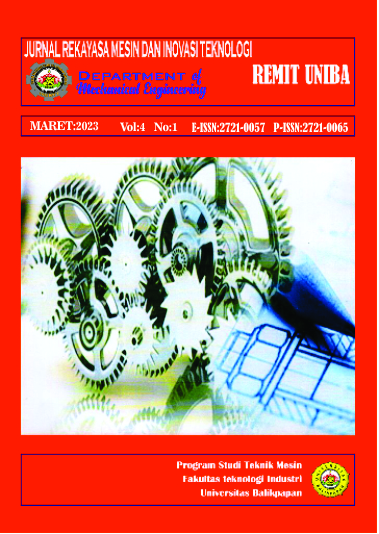Design and Simulation of Static Loads on Inovasi Karya Nusa (IKN) Electric Car Frames
Electric Car Frames
Keywords:
Frame, simulation static loading, von misses stress diplacement safety factorAbstract
Along with the times, the most widely used energy source in the world is using conventional energy in the form of fuel oil. In order to reduce and save the use of conventional fuels, for this reason, Balikpapan University Mechanical Engineering Study Program designed and built an electric car by naming it Inovasi Karya Nusa (IKN). The frame is a very important component in a vehicle, especially in IKN electric cars. In this study, making the design of IKN electric cars, especially on the frame of electric cars, using CAD (Computer aided design) 3D. This research uses the finite element analysis method. The independent variable in this study is the variation of meshing in the simulation (fine) using two comparison materials carbon steel ST37 and ASTM A106 Grade B. The dependent variable in this study refers to the simulation by determining the maximum strength value of von misses’ stress, displacement, and safety factor on the frame of the IKN electric car. The control variable in this study is the IKN electric car frame using 3D CAD with material using Carbon Steel ST 37 (seamless pipe) material size Ø 1 inch sch 40 diameter and 3.4 mm thick. The results of von misses’ stress simulations obtained by these two materials show that both materials do not exceed the yield strength limit that has been determined in mechanical properties. There is a displacement simulation on both materials obtained, so the results experienced in the simulation shown the largest is 1.5. In the results of the safety factor where the minimum value in safety is at least 2.6. The maximum value of von misses’ stress obtained from the simulation of these two materials does not exceed the yield strength limit determined in mechanical properties. The results experienced in the largest displacement simulation are 1,537 mm so it can be said that the material is within safe limits because it is far from a shift of 2 mm. The safety factor obtained in these two materials is not far comparable, so it can be said that the frame of the innovative electric car by Nusa IKN is safe after the simulation process.
References
M. A. Rahman, “Pembuatan mobil listrik untuk solusi transportasi ramah lingkungan (mobil baskara),” J. Ris. Drh., vol. XII, no. 2, pp. 1819–1837, 2013.
S. Panich, “Design and Simulation of,” J. Med. Res., vol. 12, no. 3, pp. 30–40, 2012.
M. Azhar and D. A. Satriawan, “Implementasi Kebijakan Energi Baru dan Energi Terbarukan Dalam Rangka Ketahanan Energi Nasional,” Adm. Law Gov. J., vol. 1, no. 4, pp. 398–412, 2018, doi: 10.14710/alj.v1i4.398-412.
M. Adriana, A. A. B.P, and M. Masrianor, “Rancang Bangun Rangka (Chasis) Mobil Listrik Roda Tiga Kapasitas Satu Orang,” J. Elem., vol. 4, no. 2, p. 129, 2017, doi: 10.34128/je.v4i2.64.
R. Fauzan et al., “Analisis Kekuatan Rangka Mobil Listrik Otonom Menggunakan Finite Element Method ( Fem ) menganalisis hasil simulasi apakah memenuhi standar keamanan atau tidak . Pada penelitian ini safety factor material steel ditentukan 4 untuk beban yang steady Pada pe,” vol. 1, no. 2, pp. 21–28, 2019.
M. S. D. Ellianto and Y. E. Nurcahyo, “Rancang Bangun dan Simulasi Pembebanan Statik pada Sasis Mobil Hemat Energi Kategori Prototype,” J. Engine Energi, Manufaktur, dan Mater., vol. 4, no. 2, pp. 53–58, 2020.
A. Nurtriartono, “Rancang Bangun Dan Uji Peforma Axial Brushless DC Motor Dengan Daya Output 2000 Watt,” Inst. Teknol. Sepuluh Nop., 2014.
R. Fernandus, “Perancangan Sistem Penggerak Pada Mobil Listrik Alogo Dengan Kapasitas Daya 3000 Watt / 72 Volt,” vol. lim, no. 2009, pp. 1–25, 2002.
M. Aziz, Y. Marcellino, I. A. Rizki, S. A. Ikhwanuddin, and J. W. Simatupang, “Studi Analisis Perkembangan Teknologi Dan Dukungan Pemerintah Indonesia Terkait Mobil Listrik,” TESLA J. Tek. Elektro, vol. 22, no. 1, p. 45, 2020.
O. Laka, Nazaruddin, and Syafri, “Perancangan dan Analisis Statik Sistem Rangka Mobil Hemat Energi Asykar Hybrid Universitas Riau,” Jom FTEKNIK, vol. 5, no. 2, pp. 1–6, 2018.
Sandy Suryady, Eko Aprianto Nugroho, and Abdul Muchlis, “Design Of Portable Injection Waste Destruction Machine With Sterilization System,” Int. J. Sci. Technol. Manag., vol. 2, no. 5, pp. 1800–1807, 2021.
M. A. Hendrawan, P. I. Purboputro, M. A. Saputro, and W. Setiyadi, “Perancangan Chassis Mobil Listrik Prototype ‘ Ababil ’ dan Simulasi Pembebanan Statik dengan Menggunakan Solidworks Premium 2016,” 7th Univ. Res. Colloq. 2018, pp. 96–105, 2018.
A. Mukhtar, Y. Setyoadi, and A. Burhanuddin, “Desain dan Simulasi Frame dan Bodi Kendaraan Konsep Urban Menggunakan Software CAD,” Rotasi, vol. 19, no. 3, p. 156, 2017.
H. Raghuvanshi, N. S. Ramnaveen, P. Malhotra, and A. Khatri, “Innovative design of an all-terrain vehicle (ATV),” Int. J. Eng. Adv. Technol., vol. 3, no. 2, pp. 151–157, 2013.


